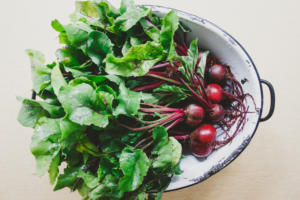Three Ways to Make Your Kitchen a No-waste Zone
A quick guide on how to re-sprout and repurpose bits of food you would normally toss.
Regrow vegetables
The list of vegetables you can regrow from scraps in your own kitchen and backyard is extensive. Carrots, onions, lettuce, celery, potatoes, most herbs, beets and other root vegetables are all easily sprouted from bits you would normally toss in the trash. Kids love to get their hands dirty and help with this project, plus it educates them about where their food comes from.
How to do it
The easiest to grow are potatoes, bulbs and roots. When potatoes start to sprout from the eyes, cut them in half, stick toothpicks in the sides and suspend the vegetable over a jar of water, allowing the roots to make contact with it. Onions, leeks, shallots and other members of the bulb family are also very easily sprouted. When you are preparing a meal with one of these ingredients, save the root end (that you would normally discard) and place it in a shallow dish of water by some natural light. Within a few days, green sprouts will emerge from the top. When the spouts grow more than an inch, you can take them outside to plant in the ground.
Use Your Seeds
Yes, you can save your avocado pit and try your hand at growing a tree. But, there is another way to highlight this nutty-flavored seed, and it has some real nutritional merit. When ground or finely shredded, like many seeds and nuts, the avocado seed can be an excellent source of calcium, selenium, fiber, potassium, magnesium and antioxidants. Quick disclaimer: there is a trace amount of persin, a natural toxin, found in the pit making this sometimes a controversial topic. However, experts almost unanimously agree you have to consume extremely large quantities to do any harm.
How to use it
First, remove the outer brown shell, which has a bitter taste. Then soak the seed for a few hours. Carefully chop up the seed into smaller pieces and add it to a blender, food processor or even coffee grinder. Use the powder in smoothies, on salads or in a pesto.
 Don’t overlook the greens
Don’t overlook the greens
Many people are quick to lob off the leafy green portions of many common root vegetables and toss them. However, beets, carrots, radishes and turnips in particular are extremely dense with nutrients and make the perfect addition to a smoothie or side dish. Beet greens top the list with benefits that include: high levels of magnesium, vitamin D, potassium, vitamins A and K and fiber.
How to cook with them
Adding the tops of these veggies to smoothies is pretty easy, just make sure not to overdo it until you are sure you like the taste. To highlight the brightly colored beet greens as part of a meal, gently wash them, removing any excess dirt. In a small bowl, toss them with olive oil, salt and pepper. In a sauté pan over medium-high heat, add a little more oil and two cloves of crushed garlic. When the garlic is browned, add a heaping handful of greens and cook thoroughly until wilted. They pair well with red meat and potatoes.



